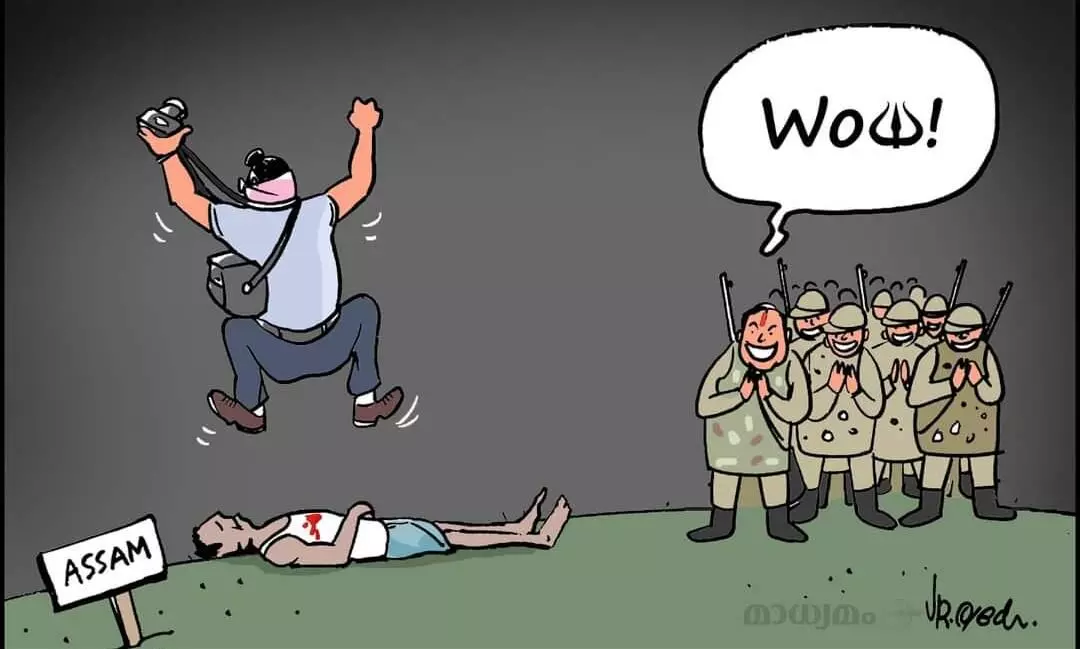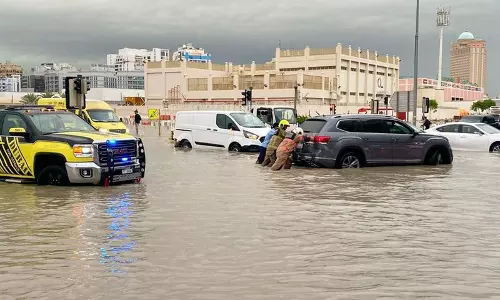

Cartoon by: V R Ragesh
Assam firing: the photographer, the presumably dead (Muslim) peasant and the rule of new mercenaries
text_fieldsThe viral video of Assam police indiscriminately firing on the poor peasants is unimaginably horrifying. The event is perhaps one of the most horrible displays of brute state power against the most marginalized people in recent public memory. However, no words are sufficient to describe the show of fierce hatred by a photographer present at the spot.
The police hired a photographer to record the event; the photographer could not control his hatred against the poor Muslim peasants. He desecrated presumably the body of a peasant protestor, who had fallen victim to the police cruelly.
The media have identified the photojournalist as Bijay Shankar Baniya. After the police firing, a peasant protestor fell to the ground and appeared unconscious, as seen in the viral video. He had received bullet injury at the hands of the Assam police.
Amid all this, the photographer appears over-enthused with the anti-Muslim hatred. He repeatedly trampled the body of the presumably dead farmer.
The incident took place in the Dholpur-Gurukhuti area under Sipajhar Revenue Circle, Darrang district, on Thursday. Political commentators allege that the BJP government of Assam has been trying to uproot many poor peasants and grab the land in the name of the Gorukhuti Agricultural Project. To serve the interests of a few big capitalists, the Hindutva government is resorting to violence.
In the firing, the police killed two peasant protestors identified as Saddam Hussain and Sheikh Farid. Several other protestors were seriously injured, while hundreds of poor Muslim peasants are facing the threat of forceful eviction.
Sadly, the mainstream media portrays the incident as "the clash" between the protestors and the police. On the contrary, it is a state terror against the innocent, poor and peaceful protestors. And, the prime target of this eviction is the Muslim peasants.
In the state's political history, the previous governments, too, have been involved in dispossessing the poor and grabbing their lands and little resources. They, too, have been anti-Muslim and anti-Dalits/Adivasis/Backward Classes/women in their approach. But the current Hindutva government seems to be far more aggressive and communal in its approach.
To serve the interests of its business masters, the Hindutva regime is using all kinds of bloody means. Besides, to justify the violent evictions in the Dholpur-Gurukhuti area, it is using its pet agenda of demonizing local Muslims as "foreigners", "illegal" migrants, "Bangladeshi", and "Rohingya". The poor peasants who have been living in the state for generations are being called now "anti-nationals", "terrorists" and are being projected as a significant "threat" to the security of the country.
The photographer is the product of this anti-Muslim discourse. His gruesome act has again strengthened the apprehension that many journalists in India today have become an armed militia of the Hindutva forces. The Hindutva forces no longer need party spokespersons as these rabidly communal, hate-mongers and venom-spitting journalists have replaced them. These journalists rate their success by the amount of polarization they create in the society and the extent to which they turn this society barbaric.
Though for the cover-up, the photographer has been arrested by the police for his actions, the state government does not seem to budge an inch on its eviction drive and lower its anti-Muslim tone. The state-sponsored mainstream media, too, are brazenly justifying the acts of the authoritarian and communal regime in the state.
The incident in Assam must propel us into action. We must not let vulture media become our source of information. The way the photographer ran to the body and kicked it repeatedly should be seen as the discretion of media ethics and Indian democracy. We should not become quiet after the arrest of the photographer or the punishment he gets. Our genuine concern should be to thoroughly diagnose the rot spreading far and wide in the mainstream Indian media every day.
It is deplorable that most media houses, sold out for the advertisements from the government and undue favours, are spreading lies and hatred. Even a graduate student of journalism knows that the role of a journalist is to report the event truthfully and fairly. The journalist derives her right from the fundamental right to freedom of speech and is accountable to the people. The journalist is expected to report and write from the perspective of the most marginalized sections of society. But they are serving the advertisements of the governments as the news of the day.
A good journalist is also expected to analyze the even in dept. Spending time with books can be a great help. Reading books should also be supplemented with the first-hand experience in the field. As an eminent Indian sociologist argues, there should be a harmony between the book and field views. Today, most journalists do not feel an urge for reading. They consider it of "little use" in their profession. They never question the category such as "illegal" occupants and "law and order" threat. History is witness to the fact that the state is the most significant source of violence and the usurper of public land and other resources.
Before jumping on the body of the farmer, the photographer did not spend a second to look at all sides of the story. While the police were heavily armed and carrying sophisticated guns, the protestors were unarmed. In reporting an event, a journalist should avoid mixing fact with opinion. In the opinion piece, one can express one's views; but a wall of separation between news and views should be maintained. The photojournalist, instead of expressing his opinion, ran to assault a protestor.
A journalist must also avoid sensationalism. The facts should be cross-checked. The language should also be lucid and straightforward; yet, the quality of content should remain uncompromised. But the way the mainstream media has reported the police firing is worrisome. To sell its plan, the angle of anti-national, Bangladesh, Rohingya were peddled. It created a sensation and fear among its readers and has propagated the views by telling them falsely that these protestors were unruly and were attacking the police.
As mentioned above, a journalist is to be accountable to people. Notably, he should keep the interest of the most oppressed at the top. He is not "loyal" to the owner of the newspaper. Nor should he articulate the interests of a particular party or a leader. But in the case of the Assam firing, the photographer fanatically sided with the oppressor.
The newsroom and editorial zone should not be a monopoly of a few castes and wealthy people. They should reflect the diversity of society. The media should also be least dependent on government patronage and corporate advertisement. But the monopoly of a few castes in the media is responsible for a news blackout on the issues and the rights of the most marginalized. Today, such a gang of journalists poses a grave threat to the harmony of the society and state of democracy in the country.
One could ask why the media houses have kept ignoring the critical issues and have repeatedly stabbed the people. Perhaps, they do so because they consider journalism as merely a profit-making business. Today, several major media houses have business interests other than journalism. Some of them are in mining, while others are in sugar and agribusiness. That is why they cannot dare to put tough questions to the government. They fear a backlash. They know that it is a give-and-take game. While the government would favour them in their business, the media houses, in turn, would keep the government happy - a trend that is fatal to Indian democracy.
(Abhay Kumar is a Delhi-based independent journalist and writer. He also teaches Political Science and Urdu. His broad areas of interest include Minority Rights and Social Justice. You may write to him at debatingissues@gmail.com.)























